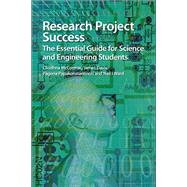
Note: Supplemental materials are not guaranteed with Rental or Used book purchases.
Purchase Benefits
What is included with this book?
| First Steps in an Epic Journey | p. 1 |
| The Research Project | p. 1 |
| Which Direction to Take? | p. 2 |
| Lecturer/Supervisor Perceptions and Misconceptions | p. 4 |
| Research Groups: Large and Small | p. 6 |
| What Resources are Available? | p. 7 |
| Project Title List - The Supervisor's Sales Pitch | p. 9 |
| Interviewing YOUR Team | p. 11 |
| Meeting Checklist | p. 14 |
| Ranking the Projects | p. 16 |
| Project Allocation | p. 17 |
| Managing the Project | p. 18 |
| Before You Do Anything! | p. 18 |
| First Steps | p. 21 |
| Arrange Your First Project Meeting | p. 23 |
| Project Objectives and Milestones | p. 24 |
| Establish a Reporting Procedure | p. 27 |
| Summary/Key Points | p. 27 |
| Searching the Literature | p. 29 |
| What is a Literature Review? | p. 29 |
| Beginning the Search | p. 31 |
| Textbooks | p. 32 |
| Journals | p. 32 |
| Web of Science | p. 34 |
| Extracting the Article from the WOK/WOS System | p. 38 |
| Patents | p. 40 |
| Web Pages and Wikipedia | p. 40 |
| Finding a Balance | p. 42 |
| Forensic Reference Hunting | p. 43 |
| Compiling the Literature Review | p. 45 |
| The First Page | p. 46 |
| Project Background | p. 48 |
| The Literature Review | p. 49 |
| How to Avoid Plagiarising Other People's Work | p. 53 |
| Summary/Key Points | p. 55 |
| Referencing Your Work | p. 56 |
| Reference Styles | p. 56 |
| The Harvard Reference System | p. 57 |
| Journals and Newspaper Articles | p. 58 |
| Books | p. 60 |
| Electronic Publications | p. 61 |
| Reference Order and Presentation Style | p. 64 |
| The Numeric System | p. 65 |
| Numeric Style Bibliographies | p. 65 |
| Vancouver Bibliography Format | p. 67 |
| Harvard vs. Numeric | p. 69 |
| Automatic Referencing Software | p. 69 |
| Summary/Key Points | p. 71 |
| Starting the Practical Work | p. 72 |
| Getting Started | p. 72 |
| Health and Safety | p. 73 |
| Notes | p. 79 |
| Acquiring Data | p. 79 |
| Instrumentation | p. 79 |
| Lab Environment | p. 81 |
| Model Systems | p. 82 |
| Data Analysis and Presentation | p. 83 |
| Presenting Your Data | p. 84 |
| Charts | p. 84 |
| A Word about Error | p. 88 |
| Equations | p. 90 |
| Tables | p. 90 |
| Summary/Key Points | p. 92 |
| Constructing the Dissertation | p. 93 |
| The Dissertation | p. 93 |
| Declaration of Originality | p. 94 |
| The Abstract | p. 95 |
| Acknowledgements | p. 95 |
| List of Abbreviations | p. 96 |
| List of Figures | p. 98 |
| Contents and Page Numbering | p. 98 |
| Chapter 1: Introduction and Literature Review | p. 99 |
| Chapter 2: Methodology | p. 100 |
| Chapter 3: Experimental Details | p. 100 |
| Chapter 4: Results and Discussion | p. 101 |
| Conclusions | p. 103 |
| Bibliography | p. 104 |
| Appendices | p. 104 |
| Summary/Key Points | p. 104 |
| Posters and Oral Presentations | p. 106 |
| Presenting Your Work | p. 106 |
| Critical Components | p. 108 |
| Presenting Posters | p. 110 |
| Poster Size | p. 110 |
| Poster Templates | p. 110 |
| Poster Background | p. 111 |
| Font Style | p. 113 |
| Font Size | p. 114 |
| General Design Considerations | p. 114 |
| Oral Presentations | p. 118 |
| Slide Design | p. 121 |
| Templates | p. 121 |
| Headings | p. 122 |
| Content | p. 123 |
| Question Sessions | p. 123 |
| Summary/Key Points | p. 125 |
| Concluding Remarks | p. 127 |
| Almost There | p. 127 |
| Adding a Final Polish | p. 128 |
| Chapter Dividers | p. 128 |
| Permission | p. 129 |
| Newspaper Reports | p. 130 |
| Bookmark | p. 130 |
| Final Steps | p. 130 |
| Subject Index | p. 132 |
| Table of Contents provided by Ingram. All Rights Reserved. |
The New copy of this book will include any supplemental materials advertised. Please check the title of the book to determine if it should include any access cards, study guides, lab manuals, CDs, etc.
The Used, Rental and eBook copies of this book are not guaranteed to include any supplemental materials. Typically, only the book itself is included. This is true even if the title states it includes any access cards, study guides, lab manuals, CDs, etc.